ISU Dining partnership with research station sprouts new crop
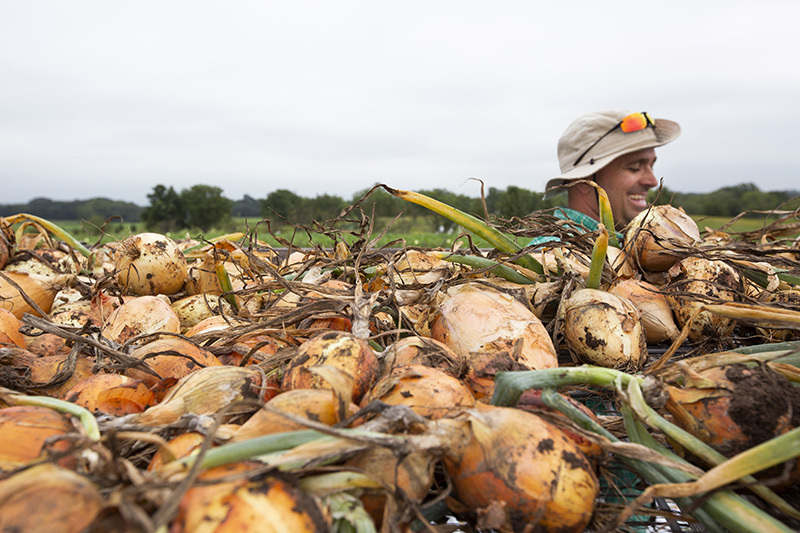
Brandon Carpenter, agricultural specialist at the Horticulture Research Station, walks a line of harvested onions Aug. 24. The crop of onions, the largest the farm has ever produced, was grown to sell to ISU Dining. Photos by Christopher Gannon.
Adding onions to peppers turned out to be a recipe for expanding the partnership between ISU Dining and the university's Horticulture Research Station north of Ames.
For years, students have been eating a wide variety of produce grown for research purposes at the horticulture farm, as available and typically in small batches. But last year, for the first time, the research station grew a crop specifically for ISU Dining, a half-acre of green bell peppers that produced about 5,000 pounds. Growing food for students on farmland researchers aren't using is a win-win, boosting the dining system's efforts to buy local and subsidizing the farm's research.
Research station superintendent Nick Howell said they chose onions as the next step in the growing initiative because they're in high demand, yet relatively easy to grow and store.
"They need thousands and thousands of pounds of onions," Howell said. "It's kind of the ideal crop."
The half-acre of yellow onions harvested last week (three varieties: Patterson, Alisa Craig and Talon) could yield up to 8,000 pounds, which will be sold to ISU Dining in 50-pound bags. Four tons of yellow onions would equal about 20 percent of the nearly 40,000 pounds the dining system bought in 2017-18, said Karen Rodekamp, ISU Dining business and support services manager.
The ISU-raised onions will be used the same as those from other vendors, though one dining center is planning a special week of locally sourced recipes, Rodekamp said. Green peppers also could be on the menu that week, as the first 600-pound shipment from the horticulture farm was delivered to ISU Dining earlier this week. Some research project crops from the farm -- sweet potatoes, pears and apples -- could find their way to students' plates this fall, too.
Cucumbers might be next up for intentional planting in 2019, Howell and Rodekamp said. Like onions and peppers, cucumbers can produce a bumper crop suitable for the dining system's needs without intensive labor. Other possibilities pose challenges. Potatoes, for instance, need to conform to size specifications, and grading spuds by hand is more work than the farm can take on.
"We understand every new crop has to be closely evaluated by their team in terms of labor, staffing, cleaning, storage and transport. So much is involved in getting it from the ground to the table," Rodekamp said.
Pepper plantings also may expand, to multicolored varieties grown in a high tunnel. An initial attempt with colored peppers didn't take this season, but Howell said they'll try it again if they have free tunnels next year. The tunnels, unheated greenhouses covered with plastic film that needs to be replaced every few years, are too expensive to sit vacant, he said.
"If there's going to be a tunnel that's empty, we're going to fill it with some type of crop," he said.
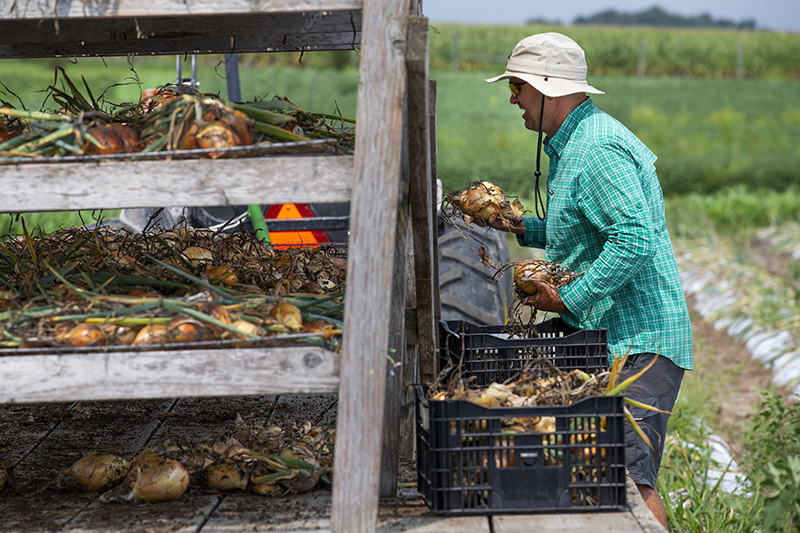
Brandon Carpenter loads onions on a drying rack at the Horticulture Research Station.
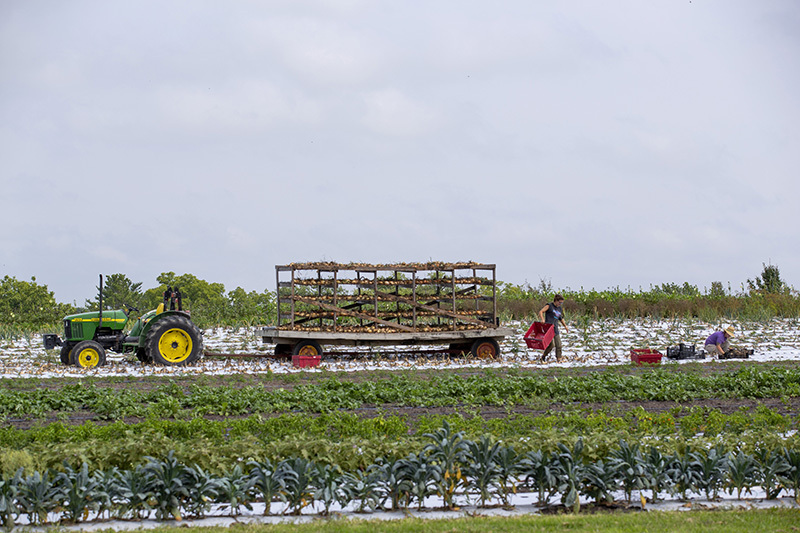
Staff and students harvest the onion crop at the Horticulture Research Station on Aug. 24.
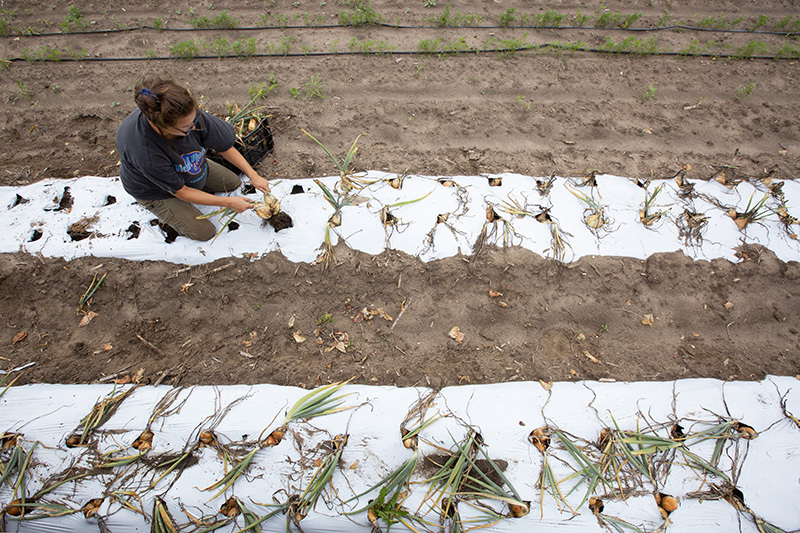
Horticulture graduate student Jean Yost harvests onions at the Horticulture Research Station on Aug. 24.
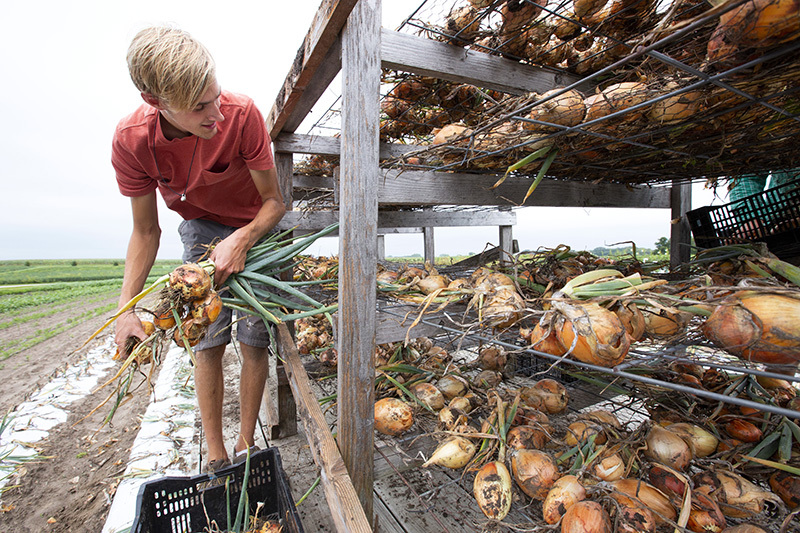
Horticulture undergraduate student Eric Hall-Floden places harvested onions onto a drying rack at the Horticulture Research Station on Aug. 24.
Dean finalists will visit campus in September
Three finalists have been selected in the search for the next endowed dean of the College of Agriculture and Life Sciences and director of the Iowa Agricultural and Home Economics Experiment Station. Each is scheduled to visit campus for two-plus days in September:
- Candidate 1: Sept. 3-5
- Candidate 2: Sept. 16-18
- Candidate 3: Sept. 26-28
Each candidate will be announced one business day before his or her visit. The candidates will meet with students, faculty, staff and stakeholders and hold an open forum with the broader university community. Forums will be held from 3 to 4 p.m. on these dates:
- Candidate 1: Tuesday, Sept. 4, MU Cardinal Room
- Candidate 2: Monday, Sept. 17, MU Cardinal Room
- Candidate 3: Thursday, Sept. 27, MU Pioneer Room
Additional information, including the finalists' curricula vitae and interview itineraries, will be posted to the CALS dean search page on the provost's office website.
The search committee is co-chaired by Guru Rao, associate vice president for research, and David Spalding, dean of the Ivy College of Business and interim vice president for economic development and business engagement.
Joe Colletti, senior associate dean of the college and associate director of the experiment station, has served as interim leader of both since Nov. 20, 2017, the same day former dean Wendy Wintersteen became the university's 16th president.
Related stories
- Listening sessions announced for CALS dean search, March 22, 2018
- Search opens for CALS dean, Jan. 18, 2018
- Colletti named interim endowed dean of Agriculture and Life Sciences, Nov. 9, 2017
Meet Peter Martin, Faculty Senate president
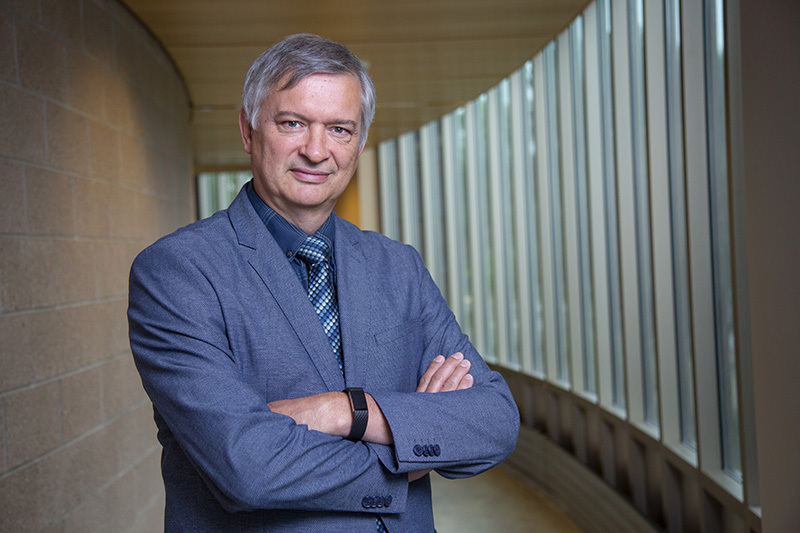
Photo by Christopher Gannon.
Position: University Professor, human development and family studies
Years at ISU: 27
Contact: 294-5186, pxmartin@iastate.edu
What strengths do you bring to your role as Faculty Senate president?
I have been at Iowa State for a long time. I have quite a bit of experience, including nine years in the Faculty Senate as a member of the executive board and several Faculty Senate councils and committees. Because of my long involvement in an interdisciplinary program (gerontology), I know faculty and administrators across campus.
What are your top priorities during your presidency?
First, we need to help implement the new term faculty policies and procedures that were passed by the Faculty Senate last year. Second, we want to emphasize the importance of diversity and inclusion on our campus and enhance the university climate for everybody so faculty feel welcome at Iowa State. Finally, we will be reviewing the way in which we conduct student evaluations of teaching.
What challenges do faculty members face this year?
We are still adjusting to Canvas as a new learning management system, and we are beginning to learn about Workday, the university’s new management software system. Iowa State also has experienced severe reductions in state support, which makes our work more difficult.
What should your constituents know about Faculty Senate?
The Faculty Senate is working with and for all faculty at Iowa State University. We make important decisions that affect every faculty member on campus. If there is something we can do better at Iowa State, we need to hear from our faculty.
How can Faculty Senate help demonstrate the value of Iowa State?
We want to be visible and accessible, and we take shared governance seriously. By taking responsibility for Iowa State, we contribute in important ways to the university community.
Meet Stacy Renfro, P&S Council president
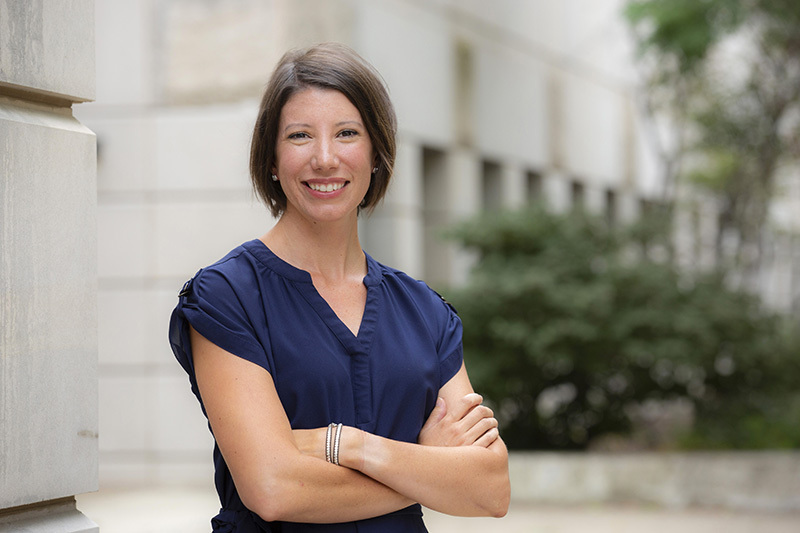
Photo by Christopher Gannon.
Position: Program manager, Center for Statistics and Applications in Forensic Evidence
Years at ISU: 7
Contact: 294-5634, srenfro@iastate.edu
What strengths do you bring to your role as Professional and Scientific Council president?
I think the biggest strength I bring to this role is my experience. The lessons I've learned and the information I've gathered along the way help me see the big picture, and as a result, I can help my team make a connection between concepts and people that might not otherwise have been realized.
What are your top priorities during your presidency?
The council itself went through a collaborative process and identified seven priorities. There's a couple I feel very passionate about, and one is supervisor training. We need more robust supervisor training because the employee experience begins with the supervisor. More effective supervisors will be impactful immediately. Council has begun collecting information from other institutions about the types and scope of supervisor training they offer, and I think that's going to allow us to make really effective recommendations in the upcoming year.
The other area I feel really passionate about is getting professional and scientific employees involved at their local department or unit level. There are some existing councils and structures in place, but we're hoping to build out a framework for employees to be more involved and form a couple more college-level or unit-level councils. I think that gives them a voice. It helps them have more ownership in what's going on in their area. And it helps us all make better decisions at the end of the day.
What challenges do P&S employees face this year?
Giving their best in the face of an enormous amount of change. Every day we're challenged to be more resourceful, more innovative and more positive in the face of an astounding amount of change happening at Iowa State. Specifically, I think the upcoming change in our enterprise system, talking about how we are going to approach institutional effectiveness or improve service delivery, and the classification and compensation review that's currently underway -- all of those will come to fruition for professional and scientific employees in the upcoming year.
What should your constituents know about P&S Council?
I think constituents should know that being involved in council is worth your time. Professional and Scientific Council is a place to contribute your skills and talents, and the work we do is incredibly impactful. And I think the work we do can also challenge your skills and give you the opportunity to utilize a different set of skills you might not be able to fully develop in your current position. Together we can help shape the future of our institution.
How can the council help demonstrate the value of Iowa State?
Professional and Scientific Council brings together employees from across the institution and illustrates our ability to collectively work toward unique solutions, engage in conversations and utilize each other's strengths. I think that really demonstrates the value of what Iowa State is about.
Getting ready for game day
The first of seven home games for the Cyclone football squad is Saturday evening, Sept. 1. For many fans, that also means the first of seven tailgate dates.
The athletics department has tweaked a few of its tailgating guidelines for the 2018 season for the safety and enjoyment of all fans. These include:
- Tailgating should not occur on elevated surfaces such as truck beds, vehicle roofs or trailers.
- Speakers that can stand alone or are connected to an amplifier are prohibited. Small "boom boxes" are permitted but the sound should be contained to your tailgate area (70 decibels limit, about the volume of a hair dryer).
It's not a change, but ISU police chief Michael Newton noted that state law prohibits hard liquor consumption or possession of an open bottle of hard liquor on public property -- which includes university parking lots. Tailgaters of legal age may consume beer and wine in the parking areas.
Other tailgate guidelines remain unchanged from past years:
- Be considerate and respectful of others.
- Limit your tailgating to your one parking space. ISU parking staff will enforce the one-space-per-pass rule.
- Do not block the drive lanes for other vehicles to park or to access parking lots or stalls.
- Maximum tent size is 10 feet x 10 feet.
- No glass bottles or kegs in parking lots.
- No open fires in parking lots.
- Professional sound equipment, for example, a DJ booth, is prohibited without prior written approval from the athletics department.
- Clean up your area and dispose of trash before departing.
Fans should be aware of a few other changes to the game day experience this year, including a new bag policy in the stadium and construction zone on the south side of the stadium.
Clear bags only
Earlier this month, the athletics department announced it is adopting a clear bag policy for football games at Jack Trice Stadium and all events at Hilton Coliseum. The policy is modeled after one used since 2013 by professional football teams -- with dozens of universities following suit. Fans are allowed to carry either a clear tote bag no larger than 12 by 6 by 12 inches or a one-gallon plastic freezer bag.
The idea is that clear bags are easily and quickly searched by stadium security staff, which keeps fans safer, reduces faulty bag searches and shortens fans' wait times to enter the stadium.
There are two exceptions to the restriction:
- Small wallets or clutch bags that are no bigger than 6.5 by 4.5 inches
- Bags containing items required for medical or child care
The athletics department provides a list of items prohibited in the stadium -- for example, beach balls, stadium seats, strollers -- and a new video on its website.
Stadium south plaza
Final landscaping work on the plaza south of the stadium will wrap up during football season, including seeding grass, planting trees and installing light poles. The construction fence will remain in place this fall to allow the grass to get established, according to project manager Jon Harvey, facilities planning and management.
The plaza is the final element of a multiphase plan to increase seating capacity in the stadium and add a club section. It serves as a visual link between the stadium and Reiman Gardens. When it's complete, the plaza will be available for use beyond football game days.
Big data, mental illness, film animation find a spot in lectures lineup
The lectures program kicks off its 61st year next week with just its third director, and Amanda Knief is keenly aware of the strength of this well-oiled machine. She said she inherited a partially stocked fall calendar from retired director Pat Miller and a staff (Molly Helmers, Joyce Knutson) who generously are "teaching me and helping move forward." There shouldn't be any hiccups in developing the lectures schedule, which averages around 120 events each academic year.
"I'm personally thrilled to be here and working in an excellent program," Knief said.
She said a priority for her will be to expand the lectures program's social media profile to reach more students and make the program work better for them.
Getting started
Tom Vilsack, former Iowa governor (1999-2007) and U.S. Secretary of Agriculture (2009-17), launches the lectures season next week in a talk about trade relations and U.S. agriculture. Vilsack serves as president and CEO of the U.S. Dairy Export Council. His lecture begins at 6:30 p.m. Tuesday, Sept. 4, in the Memorial Union Great Hall.
Below are a few other highlights from the current fall lineup. But this time of year especially, speakers confirm lecture dates almost daily. Check the lectures program site frequently for updates, Knief suggested.
Events begin at 7 p.m. in the MU Great Hall, unless noted
-
Sept. 6, "The Art of Science: Bringing Imagined Worlds to Life," Danielle Feinberg, director of photography for lighting, Pixar Animation Studio.
Go behind the scenes of "Coco," "Finding Nemo," "Toy Story," "Brave" and other Pixar films to discover how the studio interweaves art with math, science and code to create fantastical worlds. Feinberg completed a bachelor's degree in computer science at Harvard University. -
Sept. 11, "The Dark Side of Big Data," Cathy O'Neil, mathematician, data scientist and the author of "Weapons of Math Destruction: How Big Data Increases Inequality and Threatens Democracy."
Learn about the unintended negative consequences of using big data, including how "objective" black-box algorithms have the potential to reinforce human bias in everything from sentencing to hiring. Last year, O'Neil founded a consulting firm to audit algorithms for racial, gender and economic inequality. -
Sept. 24, MU Sun Room, "The Symbolism of the Sand Mandala," monks of the Drepung Loseling Monastery, Lhasa, Tibet.
From Monday through Friday, Sept. 24-28, in the MU lobby (adjacent to the postal counter), the monks will create -- and dismantle -- a mandala sand painting, a tool for reconsecrating the earth and its inhabitants. They'll pour millions of grains of painted sand from traditional metal funnels to create a mandala approximately five by five feet. -
Sept. 25, "Mental Illness, Tragedy and Transformation: The Mark Becker Story," Joan and David Becker, parents of Mark Becker, who shot and killed Aplington-Parkersburg teacher and coach Ed Thomas in 2009.
The Beckers share their experiences coping with their son's mental illness and the mental health system. They spent years visiting doctors, pleading with state mental health services and trying to get their son help for what finally was diagnosed as paranoid schizophrenia three days before Thomas' death.
The Story County Mental Health Resource Fair will precede the lecture (6-7 p.m., MU South Ballroom). -
Oct. 9, Stephens Auditorium, "A Hollywood Career in Costume Design," Ruth Carter, Oscar-nominated costume designer for Marvel's "Black Panther," for which she created more than a thousand costumes.
Carter has worked in the industry for more than three decades, with credits in more than 40 films. She received earlier Academy Award nominations in costume design for "Malcolm X" and "Amistad" and a 2016 Emmy nomination for "Roots." She also is known for her work on period ensemble films such as "The Butler" and "Selma."
